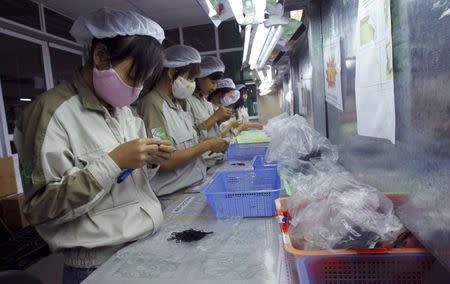Asian demand for plastic to defy China economic slowdown
By Seng Li Peng SINGAPORE (Reuters) - Asian demand for plastic is set to defy economic slowdown in top consumer China and other nations, growing as plunging oil prices make it cheaper to churn out and as fast-expanding online markets boost appetite for items like packaging and wrapping. Prices in China for polyethylene (PE), the most commonly used plastic which is found in everything from shopping bags to ice cream tubs and even artificial joints, have plummeted over a quarter from a year ago to an average of $1,140 a tonne last month according to data from commodity research company Wood Mackenzie. That follows a nearly 50-percent plunge in markets for raw material naphtha, a product refined from crude oil . And while consumers may be shying away from big-ticket purchases, they are still buying cheaper items which often come in plastic packaging, especially when ordered online, analysts and industry officials said. Continued growth in appetite in a country of 1.3 billion people is a blow to green groups pressuring for reduced consumption of plastics, and could dwarf many of the potential environmental benefits from steps such as the British government's recent push to curb usage of disposable bags. But it could be good news for key PE exporting nations such as South Korea, Taiwan and Japan, potentially bolstering companies like Hanwha Chemical <009830.KS>, Formosa Petrochemical Corp <6505.TW>, Japan Polyethylene Corporation and Japan's Prime Polymer. "(Plastic) film seems to be getting a boost from the explosion of e-commerce in China – what we call the 'Alibaba effect'. All those packages have to be wrapped," said Vince Sinclair, Wood Mackenzie's head of chemicals research for Asia. He was referring to China's biggest e-commerce firm, Alibaba Group Holding Ltd , which has been at the heart of a rapidly-growing online market in the world's No.2 economy. "Sentiment is quite negative around China commodities overall, but PE has rarely had it so good." IHS Chemical, a division of research firm IHS Inc , sees China's PE imports rising above 11 million tonnes in 2016 from about 10 million tonnes expected this year and 9.5 million tonnes in 2014. That is despite the country's economic growth slowing from a breakneck double-digit pace in past decades, as Beijing tries to transform its growth model away from a reliance on heavy manufacturing and exports. "Chinese demand so far (this year) has been good as falling prices drove buyers to replenish their polyethylene stocks. These buyers' inventories were already quite low to start with," said an official from a North Asian plastics maker that exports to China. China accounts for over 45 percent of PE consumption in resin form in Asia, said consultancy firm Frost & Sullivan. GREEN CONCERNS Growing plastic consumption is a big concern for some green groups, who say that materials are often disposed of improperly, polluting the environment. "Mismanaged plastic waste is an unintended consequence of rapid economic development. As incomes rise, people increasingly rely on consumer goods - and as a result, more plastic waste is generated," said Nicholas Mallos, a director in U.S.-based environmental group Ocean Conservancy. "In many countries, including many parts of China, waste collection and management is not to scale with countries' needs and as a result, more plastic waste enters the environment." As a whole, growth in PE consumption in Northeast Asia is expected to stand at around 6 percent in 2016, similar to the average annual rate from 2010 to 2015, but Southeast Asian growth will likely accelerate above 5 percent next year compared to an average of less than 5 percent from 2010 to 2015, said JP Nah, director of polyolefins for Asia at IHS Chemical. "Lower crude prices translate to lower feedstock costs for plastics," Nah said. "Lower plastics prices not only encourage consumption but create the possibility of other products that are making use of metals/glass/paper to switch to plastics." He added that such a switch would take time and substantial investment in research and development, but said he knew of one company considering replacing glass containers for their products with plastic bottles. And analysts said that growth would also be stoked by Indian appetite for plastic piping to be used in water projects and increasing consumption in the country of products that sell quickly and at low cost such as processed foods and soft drinks. Nikhil Vallabhan, a consultant at Frost & Sullivan Asia Pacific, said that Indian spending on those products, sometimes called fast-moving consumer goods, would grow at annual compound rate of over 11 percent from more than $12 billion in 2015. "China still accounts for the lion's share of consumption. However, it's not the fastest growing market," said Sinclair at Wood Mackenzie. "It has been overtaken by India - though of course India has a smaller demand base." (Reporting by Seng Li Peng; Editing by Joseph Radford)

 Yahoo News
Yahoo News 

